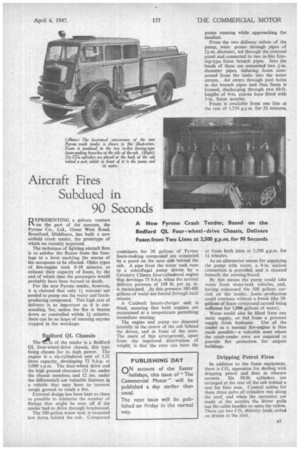Aircraft Fires Subdued in 90 Seconds
Page 37

If you've noticed an error in this article please click here to report it so we can fix it.
A New Pyrene Crash Tender, Based on the Bedford QL Four-wheel -drive Chassis, Delivers Foam from Two Lines at 2,500 g.p.m. for 90 Seconds REPRESENTING a private venture I N. on the part of the concern, the Pyrene Co., Ltd., Great West Road, 13rentford, Middlesex, has built a new airfield crash tender, the prototype of which we recently inspected.
The technique of fighting aircraft fires is to subdue the flames from the fuselage to a level enabling the rescue of the occupants to be effected. Older types of fire-engine took 8-10 minutes to exhaust their capacity of foam, by the end of which time the passengers would probably have been burned to death.
For the new Pyrene tender, however, it is claimed that only 11minutes are needed to pump out the water and foamproducing compound. This high rate of delivery is as important as it is outstanding, for, unless the fire is beaten down or controlled within 14 minutes, there can be no hope of rescuing anyone trapped in the wreckage.
Vford QL Chassis
The s of the tender is a Bedford.
QL four-wheel-drive chassis, this type being chosen for its high power. The engine is a six-cylindered unit of 3.52 litres capacity, developing 72 b.h.p. at 3,000 rpm. The four-wheel drive and the high ground clearance (21 ins, under the chassis members and 12 ins, under the differential) are valuable features in a vehicle that may have to traverse rough ground to reach a fire.
External design has been kept as clean as possible to minimize the number of fittings that might be torn off if the tender had to drive through brushwood.
The 500-gallon water tank is mounted low down behind the cab. Compound containers for 30 gallons of Pyrene foam-making compound are concealed by a panel on the near side behind the cab. A pipe from the water tank runs to a centrifugal pump driven by a Coventry Climax four-cylindered engine that develops 75 b.h.p. when the normal delivery pressure of 150 lb, per sq. in. is maintained. At this pressure 380-400 gallons of water are forced through each minute.
A Caldwell heater-charger unit is fitted, ensuring that both engines are maintained at a temperature permitting immediate starting.
The engine and pump are disposed laterally in the centre of the cab behind the driver, and in front of the crew. The merit of this arrangement, apart from the improved distribution of weight, is that the crew can have the pump running while approaching the incident.
From the two delivery valves of the pump, water passes through pipes of 24-in, diameter, led through the external panel and connected to two in-line foreing-type foam branch pipes. Into the heads of these are connected two i-in. diameter pipes, inducing foam compound from the tanks into the water stream. Air enters through port holes in the branch pipes and thus foam is formed, discharging through two 60-ft. lengths of 4-in, canvas hose fitted with 3-in, foam nozzles.
Foam is available from one line at the rate of 1,250 g.p.m. for 24 minutes, or from both lines at 2,500 g.p.m. for 14 minutes.
As an alternative means for supplying the pump with water, a '4-in, suction connection is provided, and is situated beneath the running-board, By this means the pump could take water from water-tank vehicles, and, having exhausted the 500 gallons carried on the tender, foam production could continue without a break (the 30gallons of foam compound carried being sufficient for 1,004 gallons of water).
Water could also be lifted from any static supply, or fed from a pressure
supply from hydrants. Use of the E ender as a normal fire-engine is thus made possible—a valuable asset where the crash-tender crew are required to provide fire protection for airport buildings.
Dripping Petrol Fires
In addition to the foam equipment, there is CO, apparatus for dealing with dripping petrol and fires in obscure corners. Six 50-lb. cylinders are arranged at the rear of the cab behind a seat for four men. Control cables for these three pairs of cylinders run along the roof, and when the operators are ready at the nozzles the driver pulls out the cable handles to open the valves. There arc two CO„ delivery leads reeled on drums at the rear.












































































